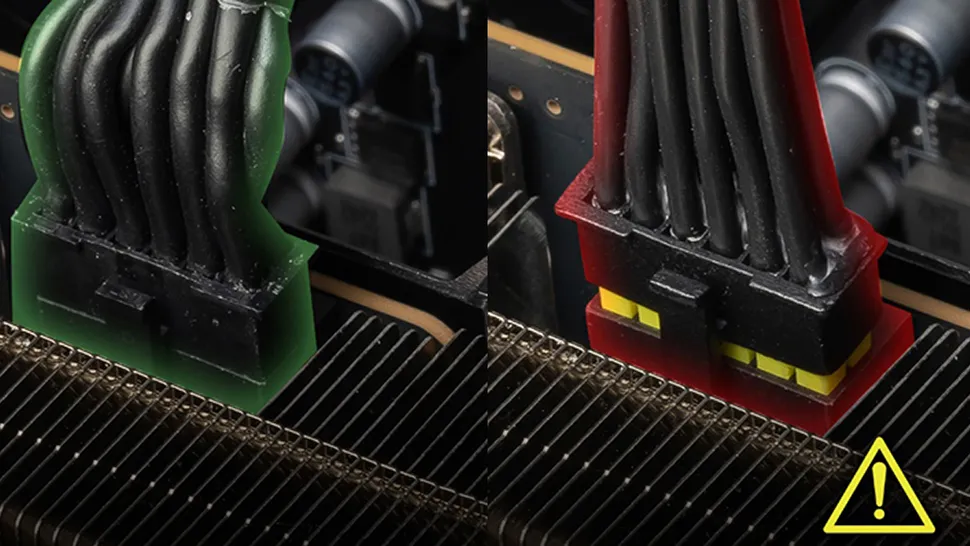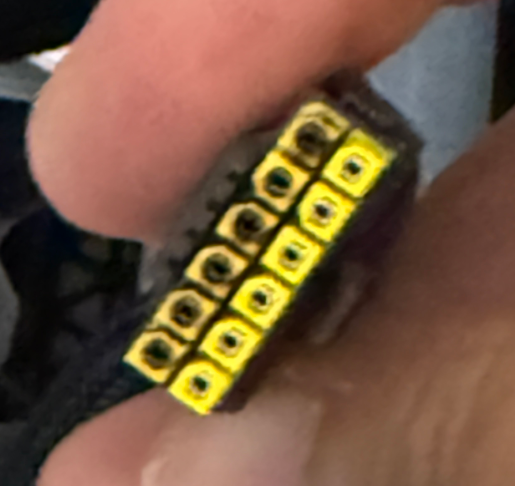MSI's 'secure' yellow-tipped RTX 5090 12V-2x6 cable is still vulnerable to melting, user report suggests

Melting RTX 50 issues keep emerging like there's no tomorrow, and this probably won't change until Nvidia tightens up the power delivery or revises the design altogether. A user at Quasar Zone reported thermal damage on MSI's preventive yellow-tipped 12V-2x6 power cables, which were originally meant to simplify cable seating and prevent melting, via Harukaze. Thankfully, the accompanying RTX 5090 remains unharmed, at least by visually inspecting its power connector.

This issue is not newfound, as the 12VHPWR connector has also wreaked havoc on a handful of last-gen RTX 40 GPUs as well. RTX 50 GPUs draw power through the six 12V terminals on the 12V-2x6 connector, each with a strict current limit of 9.5A. Naturally, GPUs have load-balancing capabilities, but reference RTX 50 models are unable to determine per-pin current measurements, preventing effective load distribution across the pins, and that's a design choice Nvidia made.
Consequently, a poor connection on some pins forces the entire load through the correctly seated ones. Several reviewers have witnessed this firsthand, with individual pins spiking to more than 150 degrees Celsius.
The affected user owned an MSI RTX 5090 Suprim, which came bundled with MSI's yellow-tipped 12V-2x6 cables (4x 8-pin to 16-pin), serving as a foolproof visual aid for ensuring proper connector seating. Likewise, power was supplied by an ATX 3.1 compliant 1,300W supply from Superflower, so the PSU wasn't the source of the problem. Either way, all it took was a small gaming session with the GPU at 400W for the user to discover an entire 12V terminal row on their cable, burnt to a crisp.
Did you know?🧐 MSI graphics cards come with a special dual-color 16-pin PCIe cable!If you see yellow, your connection isn't secure😮 Make sure to connect it properly, and game on with confidence!*This dual-color design applies only to the 1-to-3 and 1-to-4 dongles. pic.twitter.com/KuKWbej3dfApril 1, 2025
Keep in mind, the yellow tip is merely a visual aid, and errors can still go unnoticed, well, until they melt your GPU. It's impossible to know if there was user error involved or not. According to UNIKO's Hardware, the materials used in MSI's yellow-tipped 16-pin to 16-pin (native) cables differ from those in their 4x 8-pin to 16-pin adapter. Regardless, the larger problem is the inherent design of Blackwell GPUs, which cannot seemingly handle power imbalances.
Asus' Astral works around that by including a series of shunt resistors that alert users if a specific pin is drawing excessive current. Zotac's safety light mechanism is also a noteworthy mention, as it prevents your GPU from powering on if the cable isn't inserted properly. Maybe try building your own power connector, with per-pin sensing, and a current-overload alarm, as that's what a Chinese enthusiast apparently did.
Follow Tom's Hardware on Google News to get our up-to-date news, analysis, and reviews in your feeds. Make sure to click the Follow button.
Get Tom's Hardware's best news and in-depth reviews, straight to your inbox.

Hassam Nasir is a die-hard hardware enthusiast with years of experience as a tech editor and writer, focusing on detailed CPU comparisons and general hardware news. When he’s not working, you’ll find him bending tubes for his ever-evolving custom water-loop gaming rig or benchmarking the latest CPUs and GPUs just for fun.
-
Elusive Ruse This looks like the issue discovered by Buildzoid or Igor I think; apparently the current is not divided among the 12 pins equally and only a handful of them carry the majority of the load.Reply -
Notton What's concerning is that of the 6 pairs, 4 of them are burnt at 400W.Reply
Unless the power draw was actually at 600W and the software/hardware (unsure which) is under reporting. -
TheyStoppedit Honestly..... really..... it just boils down to human stupidity on NVidias part. It might as well be criminal negligence at this point. You have billions of dollars and you pay high-profile engineers and electricians millions of dollars to build your product, and you still fail grade 9 electricity. der8auer's and buildzoid's videos from February explain this thoroughly. When you have multiple wires powering a device.... THEY ABSOLUTELY UNEQUIVOCALLY MUST BE CURRENT BALANCED. If they are not current balanced, they will melt. You learn this is grade 9 electricity. But it's okay, leave it to a $2.4T company to fail grade 9 electricity.Reply
Our trusty 8-pin connector almost never melted because it was way under-specced, and they were current balanced on the board. If your connector is designed in such a way that it will melt if it's out of place by 1/10th of a millimeter, your connector is garbage. I have said it for years and I will say it again: NVidia, blaming the user isn't going to fix the problem. Acknowledge your mistake, own it, and fix it. I'd hate to see how many 4090 and 5090 owners have melted connectors and don't even know it yet.
Have you ever noticed there were almost never any reports of 3090Ti's melting (450W TDP like the 4090, 12VHPWR connector)? I wonder why that could be? Again.... buildzoids video..... The 3090Ti was FORCED to be current balanced so that if any wires were carrying too much load, the card would not work, thus, no melting. 3090Ti's current balanced. 4090s and 5090s just don't. Instead, they melt, and they will keep melting..... and melting..... and melting..... until either a class action lawsuit or a recall.
Honestly, if I were handed a 5090 for free on a silver platter, I wouldn't take it. No joke. Why? Because I'd be too scared of it melting. I do rendering and leave my GPU overnight on full load rendering. I'm not interested in being woken up by the smell of burnt plastic. It's not a chance I'd be willing to take. It shouldn't be that way. People shouldn't have to abstain from getting a consumer product due to fear of a fire. That shouldn't be the case with any consumer product. If it's not safe, its not safe. Time for a recall/class action lawsuit. -
Hooda Thunkett To me, it looks like every pin on that row overheated from the inside to some degree. Which, if I'm right, means they each were carrying too much current either simultaneously or one at a time. This doesn't seem like an installation problem, especially with that plug design.Reply
This is a design issue, and a very significant one. We wouldn't accept $40 space heaters that melted their plugs and wall sockets this often. Why is it okay with $1200 graphics cards? -
butidontwantausername Reply
You could ask "Why are people paying $3k+ for a card that's overpriced at $2k" and get the exact same answer: Because people are stupid. I can't see any other reason anyone would buy a product known to fail by melting and catching on fire. And even assuming a best case scenario where the card only destroys itself and not the rest of the PC, you're still out of a rig until you get the card RMA'd.Hooda Thunkett said:We wouldn't accept $40 space heaters that melted their plugs and wall sockets this often. Why is it okay with $1200 graphics cards? -
FunSurfer The "12V-2x6 cables' pins losing connectivity" needs further investigation. I think that overheating may cause some resistive substances to form on some pins, even if the connection is good, thus making the gpu transfer the power on less pins, creating more resistive substances, heat and finally meltdown, in a positive feedback loop.Reply
Experiments should be done with materials that will prevent these substances to form.
From personal experience, meltdown happened to me on the 2500W water boiler caused by black resistive substance that formed on the electrical wire, cleaning the wire and applying WD-40 on the wire and electric connection prevented another meltdown. Currently I don't have a gpu with 12V-2x6 connector, but I applied some WD-40 on PCIe and 8-pins connectors in an old PC to see if it will cause any harm, but it didn't. Maybe there is a better material for this. Until better connector will be made. -
Mr Majestyk No amount of window dressing by AIB's will fix a fundamentally broken board design from Nvidia. They need a super refresh that redesigns the gpu boards from the ground upReply -
alceryes A little history to show how we got here.Reply
When the connector was first trialed, on the 3090Ti/3090/3080Ti/3080 FE cards, NVIDIA put three shunt resistors (one per 12V pair) on the card PCB itself. We had no issues because the card just wouldn't power on (or would power itself off) if the load was significantly unbalanced.
NVIDIA was proud of their creation! They took their wonderful idea to PCI-SIG (PCI-SIG tests and creates the spec). NVIDIA is the largest partner of PCI-SIG and my guess is that NVIDIA threw a ton of money at getting the connector certified, showing PCI-SIG their test data for the RTX 30x0 series cards.
What no one knew (or failed to report if they did know) was that the extra shunt resistors on the RTX 30x0 cards were masking a critical flaw of the 12VHPWR design. When the 40x0 series cards came out, the 12VHPWR was the new, fully certified spec., but NVIDIA (on the FE cards) added shunt resistors in a way to nullify any protection from having them load balance - melting 4090s ensued, and melting 40x0 and 50x0 cards continue to this day.
As to why it's not fixed...? I seriously think it's hubris on NVIDIAs side at this point. NVIDIA is the biggest company in the world. They can't be wrong, right?
NVIDIA could go back to the 30x0 series design and start putting a shunt resistor on the PCB per pair of 12V pins, on all their FE cards. They could put out an addendum for their card designs stating that shunt resistors are required for all xx90 and xx80 class cards. Why don't they...? Too much of a fallout is my guess. By doing this they would admit that the design is at fault. They are just too proud and/or too much of a bully to admit that they made a mistake and were wrong.